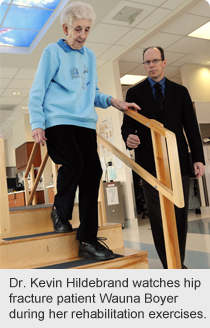
May 2, 2013
Story, photo and video by Colin Zak
Wauna Boyer has nine children, 20 grandchildren, 20 great grandchildren and five great great grandchildren. She spends a lot of time on her feet.
After fracturing her hip last September, the 87-year-old Calgary woman was relieved to undergo surgery the following day.
“My hip broke when I sat down to eat supper,” Boyer recalls. “I was surprised how quickly I had my operation. Everything was great and I had no pain whatsoever.”
 Boyer, and about 2,400 other Albertans who undergo hip fracture surgery every year, will now receive the same high level of standardized care, regardless of where they live, with the establishment of a provincial Hip Fracture Care Pathway.
Boyer, and about 2,400 other Albertans who undergo hip fracture surgery every year, will now receive the same high level of standardized care, regardless of where they live, with the establishment of a provincial Hip Fracture Care Pathway.
Developed by the Bone and Joint Health Strategic Clinical Network of Alberta Health Services (AHS), the pathway guides the patient journey at every step, from arrival in the emergency department to surgery to rehabilitation.
It aims for patients to receive surgery within 48 hours of sustaining a hip fracture 80 per cent of the time, and have patients up and moving, with assistance, one day after surgery 95 per cent of the time.
Dr. Kevin Hildebrand says this helps to get patients like Boyer back on their feet sooner.
“Patients throughout Alberta will receive surgery within a standard wait time after they fracture their hip and be mobilized one day after their operation,” says Dr. Hildebrand, co-chair of the Hip Fracture Care Pathway. “Patients who get their procedure sooner and who are up and moving soon after surgery have better results and quicker recovery. And having one pathway ensures consistent, quality care to all patients, whether they live in a big urban centre or a small rural community, which is one of the benefits of having an integrated provincial health system.”
In the past, patients could face delays in receiving surgery if they had complex medical conditions or used medications, such as blood thinners. Without a standard road map for care, Alberta hospitals did not have consistent timelines around time to surgery, re-mobilization and rehabilitation after hip fracture surgery.
The Hip Fracture Care Pathway was introduced last December in 12 orthopedic trauma hospitals across the province,
Preliminary data is now being gathered. An audit is expected this fall and will show how the hospitals are progressing toward both targets, says Dr. Hildebrand.
Educational materials are provided to help patients and their families understand their care at every step. Care teams work closely with patients to plan early discharge from hospital, within five to seven days after their operation.
“At the end of the day, patients want to go home as soon as possible to recover,” Dr. Hildebrand says. “By safely reducing the length of time a patient spends in hospital, it frees up that space for the next patient and helps us redirect resources toward treating more patients.”
The Hip Fracture Care Pathway is one of nine projects undertaken so far by AHS’ six Strategic Clinical Networks (SCNs) and three Operational Clinical Networks (OCNs).
SCNs/OCNs are provincewide teams comprised of health care professionals, researchers, community leaders, patients and policy makers, who are dedicated to developing care pathways in a specific area of health that will enhance the patient experience, improve outcomes and standardize care delivery across the province.
“Strategic Clinical Networks have honed in on a number of priority care areas – improving the hip fracture patient journey is just one example. This is part of a unified approach to improving the health of all Albertans,” says Tracy Wasylak, Vice President of Strategic Clinical Networks with AHS.
“Through SCNs and OCNs and projects like this one, Albertans are working together to make it easier and quicker for patients to get the best health care possible.”
For Wauna Boyer – whose procedure and rehabilitation were part of the Hip Fracture Care Pathway pilot project – it means a returning to normal life, sooner.
“What stood out for me was the staff – they were just great,” she says. “In rehab, they taught me how to go up and down stairs. Now I’m home and walking and feel just great.”